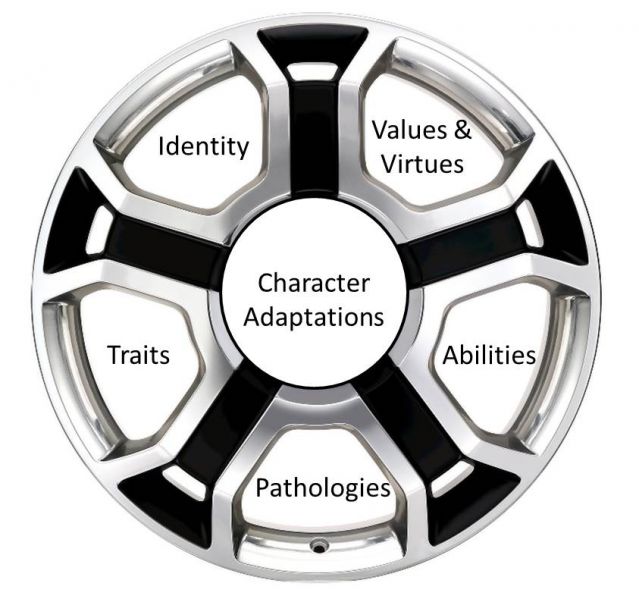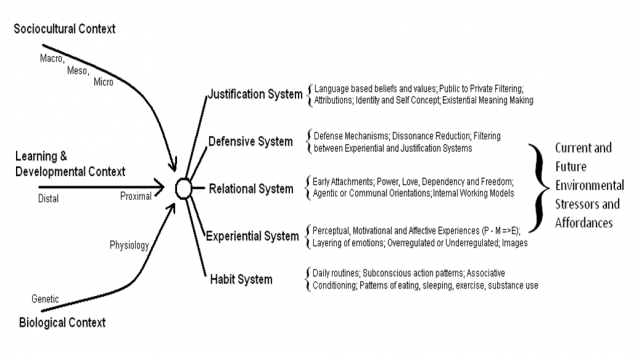Intelligence
The Character Wheel of Development
The six key domains of character development.
Posted April 18, 2014
What is the best way to understand someone’s character? Is it by understanding their morals and virtues like Aristotle suggested (see here)? Is it via examining their underlying subconscious motivational conflicts like Freud suggested? What about considering the way they construct their understanding world, as George Kelly argued? Or perhaps it is best to focus on their traits, like the Big Five researchers claim? As fellow PT blogger John Mayer notes, many people have carved up the personality pie many different ways. From my perspective, each of these points of view has some validity (in addition to many others). But what is lacking is a view of character (or personality) that is relatively straightforward, comprehensive and effectively incorporates key insights from the major perspectives. In this blog, I offer up “The Character Wheel” as an attempt to provide an outline of the six major domains of character that I believe provides a useful, integrated and relatively comprehensive map that can guide in our understanding of people.

The Character Wheel
In the center of the wheel are the “character adaptations,” which are five systems of adaptation that have evolved that enable humans to adjust to the demands of the environment. The five systems of adaptation are as follows: 1) the habit system; 2) the experiential/feelings system; 3) the relational system; 4) the defensive system; and 5) the justification system. Here is a link that describes these systems in greater detail and here is another link that describes how a clinician can assess each one to develop an integrative holistic conceptualization for work in psychotherapy.

As depicted by this figure, these systems of adaption exist in a bio-psycho-social context and respond to the current environmental stressors and affordances. In addition, these systems can be assessed for adaptive or maladaptive patterns and correspond to major perspectives in individual psychotherapy, as depicted in this figure.

Despite their richness, the systems of adaptation do not provide a wholly comprehensive framework for understanding all the key domains of character and individual differences. The other five domains refer to areas that psychologists have done empirical work on elucidating key elements of individual difference. These domains can be thought of as filling out the circle in the middle of the above diagram. In addition, I use the metaphor of a wheel to indicate a dynamic, changing conception of the person that can move in a positive direction or become stuck, depending on context and the functional inter-relations between the domains.
Traits are perhaps the best researched domain of personality. Psychologists have identified five broad trait clusters, referred to as the Big Five, that are largely present across cultures and generally remain at consistent levels in adults after the age of 25. The five primary traits are: Neuroticism, Extraversion, Agreeableness, Conscientiousness, and Openness. There are many measures of the Big Five (see here and here) and for an excellent approach to using the Big Five in a sophisticated analysis of character see here.
Identity was formally highlighted by Dan McAdams (in addition to character adaptations and traits) as a central domain of personality in his important article, A New Big Five. Identity here refers to the person’s narrative of self, and includes their self-concept and their level of ego development (described in this blog), their sense of agency and the coherence and complexity of self-states. From a more neuro-psychological view, this domain includes an individual’s capacity for executive functioning, and capacities for self-regulation.
Abilities refer to the skills and talents an individual has to function effectively in the environment. Intelligence is probably the best studied ability and recent developments in the Catell-Horn-Caroll theory of intelligence provide a useful map of this complicated construct. Howard Gardner made a useful contribution to the concept of abilities with his notion of multiple intelligences. The domains of abilities to assess in addition to intelligence include creative/artistic, athletic, and personal/socio-emotional skills and talents.
Values and Virtues refer to the moral values and character virtues and strengths of the individual. Jonathan Haidt’s work on moral foundations theory is relevant and identifies six broad moral value dimensions that guide the ideologies of individuals and groups, which are as follows: 1) Care/Harm; 2) Fairness/Cheating; 3) Loyalty/Betrayal; 4) Authority/Subversion; and 5) Sanctity/Degradation. Peterson and Seligman identified a group of character strengths and virtues that overlap some, but focus more on the characteristics an individual values in themselves or others, and include: 1) Wisdom/Knowledge; 2) Justice; 3) Temperance; 4) Transcendence; 5) Humanity; and 6) Courage. Finally, Blaine Fowers, reviewing Aristotle’s perspective offers a useful framework to consider ways in which individuals operate in relationship to moral systems (see here).
Pathologies and vulnerabilities refer to a DSM-like characterization of difficulties in functioning and would include problem domains such as: 1) Mood/Emotion Dysregulation (e.g., depression, anxiety, shame, anger); 2) Cognitive Processing Problems (e.g., attention, memory, focus); 3) Disturbances of Cognitive Content (e.g., intrusive or bizarre thought patterns, hallucinations, delusions); 4) Behavior Regulation Problems (e.g., eating, drinking, substance misuse, compulsive behavior); and 5) Relational Disturbances (e.g., lack of relational value/social influence, lack of intimacy, sense of isolation, chronic conflict).
I recognize that there is quite a bit of information here. My desire is to develop a way such that the information from these domains can be effectively assessed and then a psychological check-up can be developed such that an individual could be informed regarding their function in these domains in a useful way. I should also note that I realize these domains overlap some. Work needs to be done culling down unnecessary overlap.
Finally, as social psychologists are fond of pointing out, situations and contexts matter tremendously—a fact I wholeheartedly acknowledge. However, clinicians are given the charge of understanding why people do what they do and how they will likely adapt in the future, across situations. As such, we need heuristic frameworks that help organize the vast empirical literature on character and personality and does so in a way that enables the key insights to be brought together into a workable rubric. This is what I am trying to accomplish with the Character Wheel.




